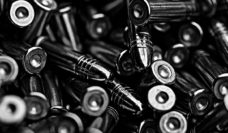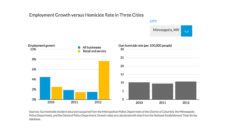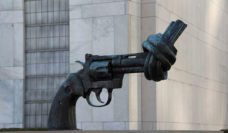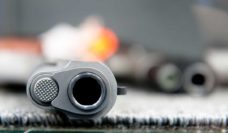In April of 2016, a 13 year old boy was cared for at my institution after being shot by a veteran police officer while carrying what appeared to be a semiautomatic pistol. Police later discovered that the boy was carrying a Daisy Powerline 340 BB gun which is crafted to closely resemble a Beretta semiautomatic handgun.
Stories like this and that of Tamir Rice, a 12 year old boy who was shot and killed by police while carrying a BB gun made to resemble a Colt M1911, are not accidents. These incidents are public health problems with public health solutions. They should and can be prevented. Since the publication of our viewpoint article in JAMA Pediatrics in 2017, a few cities have banned these types of BB guns, but they remain readily available in stores across the country and online. Recent events prompt renewed attention to this important issue.
The guns shown in the figure are examples of a common service weapon for US law enforcement and a BB gun manufactured by Daisy that looks almost identical to it. When police and others are forced to differentiate between two indistinguishable guns, the consequences can be devastating or even deadly.
BB guns that are designed and manufactured to be indistinguishable from real guns are a public health problem.
Because there is no central database or reporting system for incidents involving BB guns that look like real guns, it is difficult to determine the burden of injuries and deaths related to them. We turned to the data on officer-involved shootings as a proximate means of identifying one source of injuries related to these types of BB guns. A Washington Post study of officer-involved shootings found that 992 people were killed by police in 2018. Three percent of those, 33 people, 11 of whom were under 25 years of age, were armed with “toy weapons.” Presumably, many of these were BB guns made to resemble real guns.
In order to adequately address this problem, we must first fully understand it. To do that, federal and state databases must begin to identify death and injuries involving BB guns and BB guns made to resemble real guns as well as those deaths and injuries from officer-involved shootings.
We must also identify the most reliable means or marking systems to allow law enforcement and others to readily distinguish BB guns and non-firing toy guns from real guns. This research should inform an amendment to the Federal Energy Management Improvement Act of 1988 that would mandate the most effective marking system for both non-firing toy guns and BB guns.
Policy-making is not limited to legislative action. The Consumer Product Safety Commission (CPSC) can take regulatory action informed by the aforementioned research to require that manufacturers comply with a specific marking system that would make them safer. Finally, people who have suffered injuries or lost loved ones related to these BB guns can bring litigation against manufacturers.
BB guns that are designed and manufactured to be indistinguishable from real guns are a public health problem. It is incumbent upon the research and advocacy communities to generate evidence that can inform policy and then compel legislators and agencies to implement evidence-based strategies to prevent further injuries and deaths.
Photo by Quentin Kemmel on Unsplash














